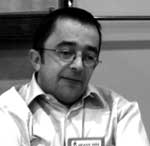
NEADS Conference 2004 - Right On!
Speakers
Steve Estey

|
Biography
Steve Estey is chair of the Council of Canadians With Disabilities’ (CCD) international committee, and on staff at Disabled Peoples’ International (DPI) where his main work is with the new UN Convention. Steve has worked with NEADS as a consultant for a number of years, and served on our board of directors’ as the Association’s President.
Audio
PowerPoint
Synopsis
As a member of Canada's delegation to the UN for the past 2 meetings of the Ad Hoc Committee, Steve is well acquainted with both the process and the details of the development of the UN Convention. He will discuss the value of the Convention, and how we -- disabled persons’ organizations around the world -- have been working to ensure that the Convention is a useful tool for the advancement and protection of the human rights of persons with disabilities.
Report
Steve Estey, Chair, International Committee, Council of Canadians with Disabilities, noted that, of the 600 million people with disabilities in the world, 400 million live in countries of extreme poverty. People with disabilities who are attending post-secondary institutions in richer countries need to remember that statistic and to participate in human rights work.
Estey discussed the overall United Nations (UN) human rights framework and the evolving human rights and disabilities framework. Those two trends have brought countries to the point where they are now discussing the creation of a human rights convention for people with disabilities.
Estey outlined the development of a system of core human rights treaties at the UN. One of the first documents passed after the formation of the UN was the Universal Declaration of Human Rights, which talks about the rights of all human beings on the planet. Those rights include (for example) rights to freedom, dignity, security, and equal treatment.
From 1948 to the late 1970s, six core human rights treaties were developed. Those treaties are now referred to as the UN “human rights architecture.”
In the mid-1970s, a realization developed in the UN system that the treaties did not take into account the differences in humanity—differences in the ways that people experience their human rights. The UN then began to develop four thematic human rights treaties focusing on racial discrimination, torture, women, and children.
A process has now been underway for a number of years to incorporate the disability perspective into international instruments. Estey presented a brief history of that process from the early 1970s to the present. The first call for a new convention on people with disabilities came in 1987, at the mid-decade review of the UN Decade of Disabled Persons.
After several more calls for a convention, the government of Mexico introduced a resolution into the General Assembly in 2001. That resolution called for the creation of a committee to look at whether a convention should be created. That more indirect approach succeeded, and the committee’s first meeting was held in 2002 in New York. At the end of the process, no consensus had developed in the committee about whether a convention was needed. Another meeting was held and, at that meeting, a resolution was passed to draft a convention for discussion (though no consensus had been reached that a convention was necessary).
Even lacking a formal consensus, momentum is now building and a convention seems inevitable. In January 2004, a working group met and prepared the first official draft text. Two two-week meetings since then have been convened to read through the draft document.
The challenges for 2005 and beyond are these:
- To find consensus that cuts across the diverse interests of people with disabilities
- To entrench judiciable human rights, without binding with a programmatic focus
- To ensure an effective monitoring mechanism
- To maintain an effective voice in change
- To translate global human rights into local benefits